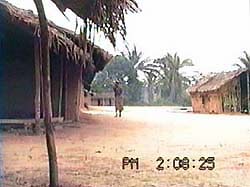|
4. “Feeling of co-presence” People's postures towards various types of utterances closely reflect their daily social experiences. I found this connection relevant especially when I examined their sense of connectivity with other villagers. In one study, I handed a notebook and a watch to several men and women and asked them to record the people whom they happened to be together with at every hour on the hour (7:00, 8:00, etc.) One of the informants who was sitting in the meeting house located near the center of the village frequently added an old woman as someone who was there, even though she was in the kitchen of his house. His house was easily 20 meters away from the place where he was, and there was a mud wall between the two. I had realized that their sense of “being with others,” that is the “feeling of co-presence,” is much different from ours. It seems that the basis for the “feeling of co-presence” between these two individuals is loud utterances. Even though they were 20 meters apart from one other, they are able to communicate with one another as if they were facing each other. Furthermore, they were readily accessible by communication even if they are not exchanging words at a given moment.
How far does this type of “feeling of co-presence” extend into villagers' lives? I have here another case reflecting its spread. When I was observing people visiting the meeting house, I realized that many people did not exchange greetings. I then looked, from various angles, at what divides people from exchanging formalities or not, and discovered that the most significant factor was the distance between the location of the two individuals' residences. People drop formalities to those who live within a range of 150–200 meters of themselves, but greet people who live beyond that range. This suggests that people living within that range are considered to be in potential contact, even if they are not face to face; that is, they share the “feeling of co-presence.” The range of 150–200 meters seems to be the determinant distance, because it is the limit that the loud voice can reach. KIMURA Daiji |
